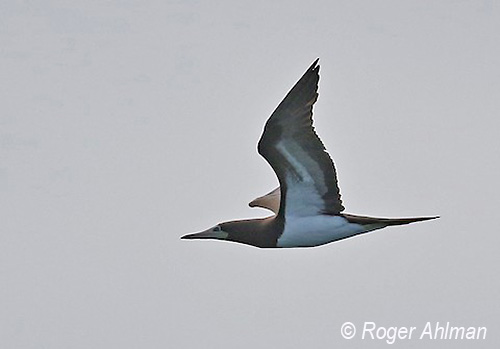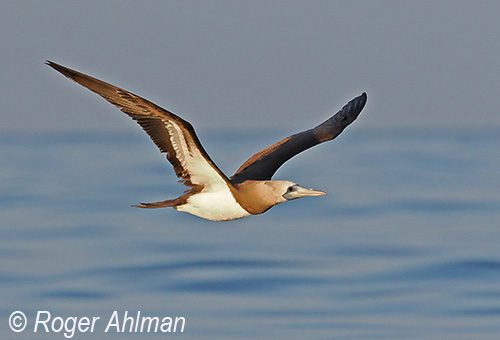
Fr: Fou des Cocos
Ang: Cocos Booby
All: Weißbauchtölpel
Esp: Piquero Pardo
Ita: Sula fosca
Nd: Bruine Gent
Sd: brun sula
Photographer:
Roger Ahlman
Pbase Galleries Peru and Ecuador
Text by Nicole Bouglouan
Sources:
HANDBOOK OF THE BIRDS OF THE WORLD vol 1 by Josep del Hoyo-Andrew Elliot-Jordi Sargatal - Lynx Edicions - ISBN: 8487334105
A Complete Guide to Antarctic Wildlife by Hadoram Shirihai and Illustrated by Brett Jarrett - Edited by Guy M. Kirwan - ALUL.A Press Oy, Finland - ISBN 9519894705
NEW AND RARE BIRDS FOUND BREEDING ON THE SAN PEDRO MARTIR ISLE.
Wikipedia, the free encyclopaedia
Cocos Booby
Sula brewsteri
Suliformes Order – Sulidae family
INTRODUCTION:
Formerly named Brewster’s Booby, the Cocos Booby was considered a subspecies of the Brown Booby. But due to morphological and behavioural differences, the present species was split in 2024 by the American Ornithological Society.
It was first described in 1888 based on birds collected in the Gulf of California.
The Latin name Sula brewsteri pays tribute to the ornithologist and avian paleontologist William Brewster (1851-1919). The species was named Brewster Booby, but it is now known as Cocos Booby, after Cocos Island of Costa Rica where it breeds.
The Cocos Booby resembles the Brown Booby in which male and female are practically similar. But the male Cocos Booby differs from the female by pale whitish head shading progressively to dark brown on the neck. However, the females of both species are nearly identical.
It is found in the East Pacific Ocean where it breeds in several locations. The breeding habitat is usually a sandy atoll or a rocky island near good food sources. The Cocos Booby feeds primarily on small fish, especially anchovies and herrings. The hunting behaviour is typical of the Sulidae that use the plunge-diving to catch their prey.
The Cocos Booby is socially monogamous and colonial breeder, nesting on islands. The nest is usually built on cliffs and other steep places, often on a flat area. But it may sometimes use small caves or “alcoves”. Both adults share most of the nesting duties.
The Cocos Booby has not yet been evaluated by Birdlife International, and both Cocos Booby and Brown Booby are still placed together, but they are evaluated as Least Concern.

DESCRIPTION OF THE BIRD:
Biometrics:
Length: 68-80 cm
Wingspan: 135-155 cm
Weight: M: 1,000-1,200 g – F: 1,300-1,450 g
The Cocos Booby adult male has dark brown upperparts, including neck, upperwing and tail, the latter being brown above and below.
On the underparts, foreneck and breast are brown, and contrasts strongly with the white belly and undertail-coverts. The gular pouch is greenish-blue to bluer, depending on each individual.
On the dark underwing, median, secondary coverts and axillaries are whitish. Primaries, leading and trailing edges are dark brown. The flight-feathers are dark greyish.
The head is very pale and contrasts with the dark brown plumage. Face, chin and throat are white, shading progressively to brown on the neck.
The bill is large and conical. The culmen is slightly concave whereas the pointed tip is bluntly. The bill base is dark slaty blue. The mandibles can be pinkish/pinkish-grey, or pale green/yellow-green. The tip is pink, more or less conspicuous.
During the breeding season, the bill becomes brighter and greener, while it turns duller and greyer during the rest of the year.
The eyes are dark varying from dark grey with distinct dark pupil, to entirely dark brown. It is rarely silvery grey. We can see a narrow, greyish-white ring around the outer edge of the eye, and a dark orbital patch, often hidden by the dark blue bill base.
Legs and webbed feet are yellowish-green to bluish. They become brighter during the breeding season. The claws are dull blue.

The Cocos Booby adult female has chocolate-brown plumage, becoming darker brown on primaries and rectrices.
Belly and undertail-coverts are white. The underwing is like that of the male.
On the brown head, the facial skin is pale greenish-yellow, and we can see a dark spot in front of the eye. The gular pouch is pale yellowish-green.
The bill is pale pinkish. The tip is usually dusky, like sometimes the cutting edges of the mandibles.
The eyes of the female are often dark greyish with distinct dark pupil. The lores are slate-blue. The bare space around the eyes is pale yellowish-green.
Legs and webbed feet are pale greenish-yellow.
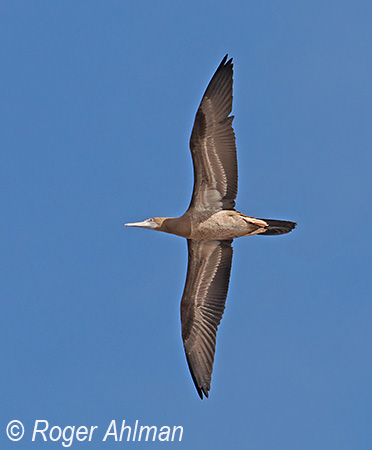
The juvenile is almost entirely medium-to-dark brown. On the upperwing, the fringes of the secondary coverts are pale to whitish.
On the underparts, the plumage varies from brown to whitish with variable brown mottling. We can see a distinct horizontal break between the brown breast and the rest of the underparts.
The female juvenile shows pale grey to whitish irises, whereas the male juvenile has dark eyes, but more information is needed.
The immature goes through a progression of changes in plumage and coloration of the bare parts.
RANGE:
The Cocos Booby breeds on Mexican islands from Los Coronados Islands and the north of the Gulf of California; S to Gerrero, the Revillagigedos (Islas Revillagigedo or Archipiélago de Revillagigedo), and Clipperton Island. It also breeds on the Cocos Island of Costa Rica.
During the non-breeding season, it is usually resident around its breeding areas, although it also disperses widely across the tropical eastern Pacific Ocean, from S California to Ecuador.
Some small, slower groups may wander N to British Columbia and SW Alaska, S to the Galapagos Islands, NW Peru and Easter Island, and also W to Hawaii and Palmyra Atoll where up to 20 individuals have been recorded.
Exceptional vagrants have been observed W to Japan, Saipan and the Aleutian Islands.
The Cocos Booby was traditionally considered a “near shore” species, but today, this bird can be seen thousands of kilometres away across the Pacific Ocean. Maybe due to ocean warming… But more information is required.
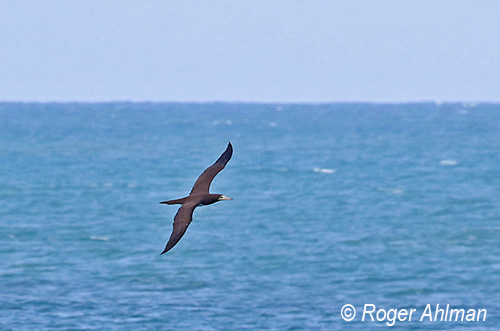
HABITAT:
The Cocos Booby breeds on sandy atolls and rocky islands where it can find some flat areas. It nests 50/100 km from food sources, where the coastal upwelling attracts prey.
The non-breeding habitat is poorly known. The species can be found over the continental shelf, also over the shelf slope, and over pelagic waters.
Despite being known as a “near-shore” species, the colonies found around Hawaii, Micronesia and the Line Islands, suggest that some groups wander far over deep water and well away from the shore.
CALLS AND SONGS: SOUNDS BY XENO-CANTO
The vocal behaviour of the Cocos Booby is not well known, but it is likely similar to the limited repertoire of the Brown Booby. Male and female have different vocalizations.
The female gives harsh quacking, braying or honking.
The male’s call is mainly a whistling sound, a soft, high-pitched, descending whistle. It is used as contact between mates and chicks. But when the male is excited or aggressive, this call becomes a more vigorous chaffing sound, often given to claim or defend the territory.
The Cocos Booby is usually silent at sea. The vocalizations are mainly given at the breeding colonies, and especially near the nest.
BEHAVIOUR IN THE WILD:
The Cocos Booby feeds mainly on small fish caught near the water surface. The prey varies from anchovies and herring which are the main prey and their preferred food, to longfin halfbeak and beauty fin flying-fish.
It feeds in deep and shallow waters, depending on fish concentration. It is often associated with upwelling, sometimes feeding with bottlenose dolphins which bring up the fish to the surface.
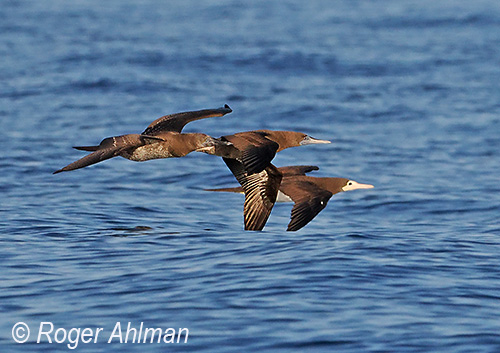
The Cocos Booby typically hunts by plunge-diving like most Sulidae species.
It performs nearly vertical dive from 1 to 15 metres above the water, but it also hunts by skimming the water surface, performing sometimes shallower dives.
The vertical dive is spectacular. See this behaviour here: The Northern Gannet, an acrobat in the sky
It often pursues its prey underwater, using its webbed feet and/or wings. It may stay underwater for up to 40 seconds.
The fish is swallowed underwater or on water surface, less often in the air.
Depending on prey abundance, the Cocos Booby may hunt in groups. It is not known to feed at night.
The Cocos Booby is socially monogamous and colonial breeder.
The courtship behaviour often varies according to the species. However, some displays are performed by most Sulidae species.
The most typical display is the sky-pointing during which neck and bill are held upwards. It is used to strengthen the pair-bond.
Pecking and mutual touching show the bird jabbing or flinging its bill at its mate. It may also touch or nibble at the bill.
Head-shake is also reported.
Vocalization and ritual behaviour accompany the nest-building. The copulation occurs within the small nest territory and often in connection with nest-building.
Numerous Coco Boobies maintain the pair-bonds at the colony from year to year.
The nest is built on barren ground, usually on bare rock. Some few sticks, seaweeds and old feathers are used to form a “cup” for the eggs. But usually, the nest materials are simple or absent, and the eggs are laid on flat rock or in shallow depression. Both adults share the nesting duties.

The Cocos Booby disperses after the breeding season; but they return to the colony 1-3 weeks before the egg-laying. Fidelity to the nest-sites is suspected to be high.
The movements of this species are poorly known. The birds depend on El Niño events and also on seasonal changes in prey availability.
The Cocos Booby usually rests at sea, but it prefers to roost on land.
The flight includes a series of vigorous flaps interspersed with glides. The Sulidae are strong, agile fliers, able to land on tree branch or vessels at sea.
It can be seen soaring along beaches, dunes and generally areas with rising air.
The bird needs to run actively to lift off from the water surface.
REPRODUCTION OF THIS SPECIES:
The breeding season of the Cocos Booby usually varies among colonies, and may sometimes extend across the entire year at some locations.
The Cocos Booby breeds in colonies on sandy atolls and rocky islands. The nest-site is on barren ground and often on bare rock, usually on flat rock or into a shallow depression. The birds select a site where the wind is relatively strong to help them to take-off.
The nest is sometimes placed on shelves and niches on the side of the rocks. It can be well built, with sticks, seaweeds and some feathers, but some nests have no material. Several nests are used for several years in a row.
This species produces a single brood per year.
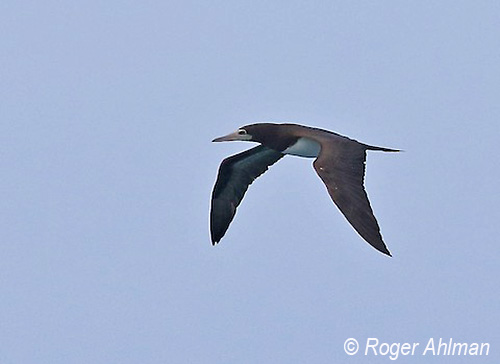
The female lays 1-2 buff-white, pale greenish-blue eggs. They are covered with a dull chalky substance. They are very similar to the eggs of the Blue-footed Booby.
Male and female share the incubation during 42 days, and feed the chicks.
At hatching, the chicks are naked, but a white down begins to develop by days 9-13. Then, by days 27-36, a thick white down covers the chicks.
The young birds fledge 90 days after hatching. They remain partially dependent on adults for food for several weeks.
The first flight is relatively short and uncertain.
PROTECTION / THREATS / STATUS:
From several observations in the Gulf of California, the breeding activity of the Cocos Booby is much reduced because of El Niño event, and most birds do not attempt to nest. The problem comes from the reduction and fluctuation of prey availability.
The population is impacted by commercial fishing for herring and anchovies. Invasive species (pigs, black rats) also disturb the reproduction on some islands. Guano collection has a devastating effect on some colonies, with constant activity on the islands.
But currently, the colonies are difficult to access, involving minimal human disturbance.
The global population of the Cocos Booby is roughly estimated at 65,000 breeding pairs, based on data from several islands. The Cocos Booby depends on El Niño event and prey availability.
The Cocos Booby has not yet been evaluated by Birdlife International, and both Cocos Booby and Brown Booby are still placed together, but they are evaluated as Least Concern.
More information is required.
